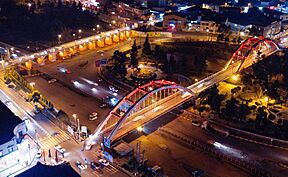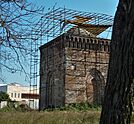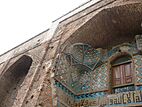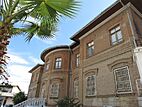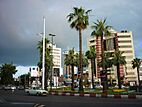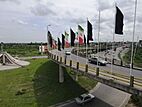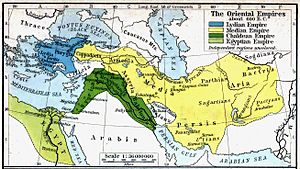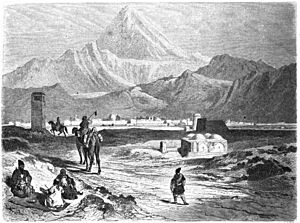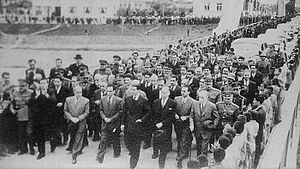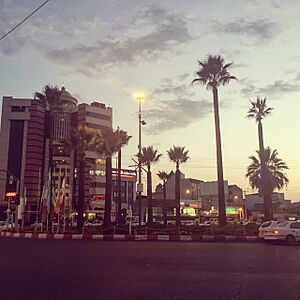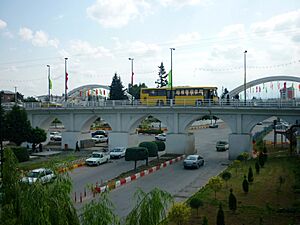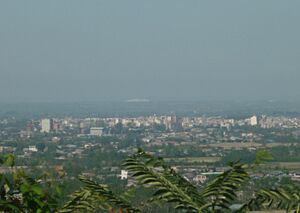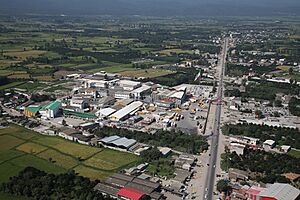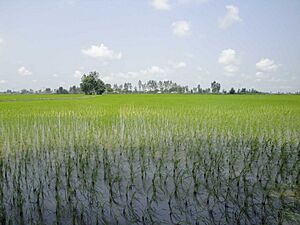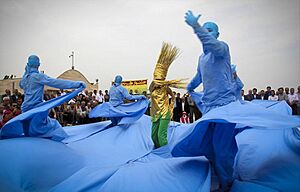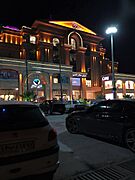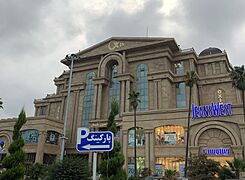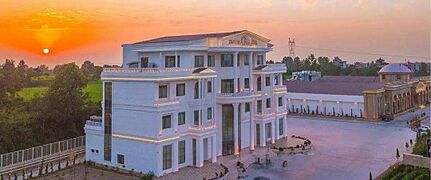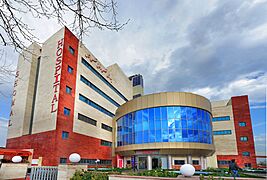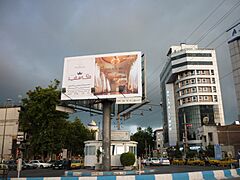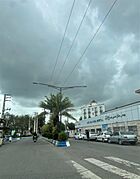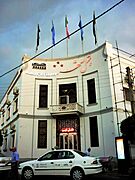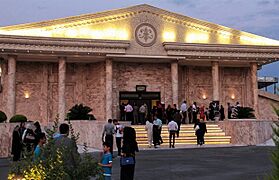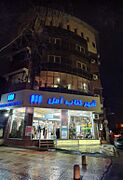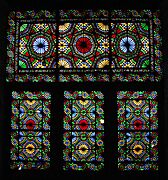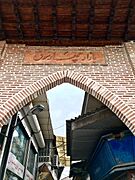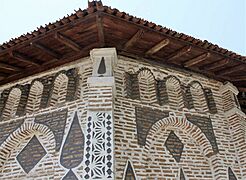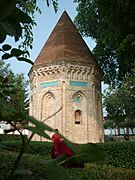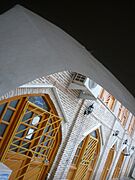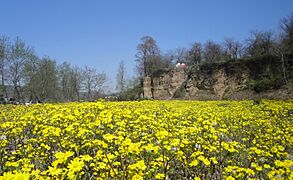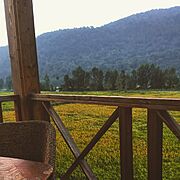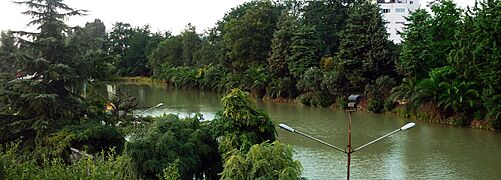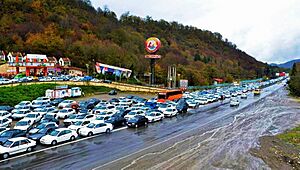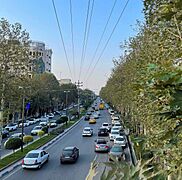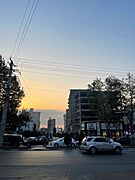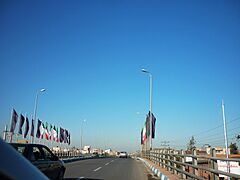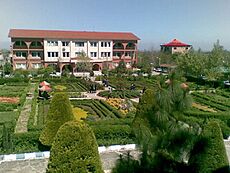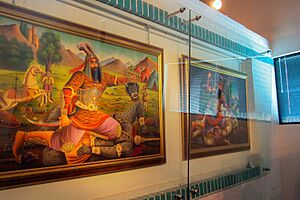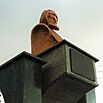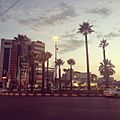Amol facts for kids
Quick facts for kids
Amol
آمل
Ancient names: Amerdad, Ameld, Amui,
Hamo, Ameleh, Amol |
|||
|---|---|---|---|
|
City
|
|||
|
|
|||
|
|||
| Country | Iran | ||
| Province | Mazandaran | ||
| County | Amol | ||
| District | Central | ||
| Incorporated (city) | 1923 | ||
| Area | |||
| • City | 21 km2 (8 sq mi) | ||
| Elevation | 76 m (249 ft) | ||
| Population
(2016 census)
|
|||
| • Urban | 237,528 | ||
| • Metro | 430,000 | ||
| Time zone | UTC+3:30 (IRST) | ||
| Postal code |
46131-46391
|
||
| Area code(s) | (+98) 11 | ||
| Website | |||
Amol (Persian: آمل [ɒˈmol]; ) is an ancient city in Mazandaran province, Iran. It is located on the Haraz River and is the capital of Amol County.
Amol is close to the Caspian Sea (less than 20 km south) and the Alborz mountains (less than 10 km north). It is about 180 km from Tehran. Amol is one of Iran's oldest cities, dating back to the Iron Age and the Amardi tribe. Today, it's a key center for industry, culture, farming, and tourism in Mazandaran. It's often called the History, Science and Philosophy city and the City that does not die.
Contents
History
Ancient Times
The name Amol might come from the Amardi tribe. They lived in this area a very long time ago. Historians think Amol was founded over 3,000 years ago. Some stories even say it started during the time of a mythical king named Tahmuras.
Early Kingdoms
Amol was an important city during the Pishdadian dynasty and Kayanian dynasty. The Amards were people who lived here before the Aryans arrived. Amol was the capital of Mazandaran for a long time, from the Sassanid Empire until the Ilkhanate dynasty.
The Amards were brave people. They helped the Achaemenid Empire in many battles, including the invasion of Greece. Ancient writers like Herodotus and Strabo wrote about them.
Achaemenid Empire
The people of Amol were strong fighters. They took part in big battles like the Battle of Thermopylae. Some of the famous Immortals (Achaemenid Empire) archers were from Amol.
Parthian Empire
During the Parthian Empire, Amol was a major city in Iran. It was known as Homo or Hamo. The Parthian King Phraates I fought the Mardas in the Amol region.
Sassanian Empire

Amol was the capital of Mazandaran from the 3rd century AD under the Sassanian Empire. It remained the capital until the 13th or 14th century. Before Islam, Amol was one of the biggest cities in the region. Coins found from this time show that Amol was a capital city.
The city had temples, markets, and fire temples. One writer, Ibn Rawi, said Amol was even bigger than Isfahan and Qazvin. The Dabuyid dynasty and Bavand dynasty also made Amol their capital.
Islamic Era
Early Islamic Dynasties
Amol became the capital of Northern Iran during the Alid and Marashis dynasties. People in Amol accepted Islam around 775 AD. The city was also the capital for the Bavand dynasty and Ziyarid dynasty.
In the 9th century, Amol was one of Iran's largest cities. The people of Amol were very strong and resisted the Arabs at first. The Zaydid dynasty made Amol their capital. Later, the Ziyarid dynasty ruled. Amol was known for its industry and silk during this time.
Safavid Period
During the Safavid rule, Amol grew a lot. Abbas II of Persia loved the city and visited often. Amol was seen as a very grand city. Many bridges were built over the Haraz River during this time. After the Mongol invasion, Sari became the capital for a while. But later, Amol became the capital again.
Afsharid Period
During the Afsharid dynasty, Amol became important for trade and making weapons. Nader Shah ordered an iron plant to be built here. This was the first artillery workshop in Iran. It made cannonballs, rifles, and horseshoes.
Qajar Period
In the Qajar era, a road and railway were planned from Tehran to Amol. Amol was a very busy trading center. Its inner city had a moat for protection. Houses were made of wood because of the heavy rain. The city was famous for wooden items, textiles, and carpets.
Many leaders of Iran's constitutional revolution came from Amol. The first modern railway in Iran was built in Amol in 1887. It connected Amol to the Caspian port of Mahmoudabad.
20th and 21st Centuries
Under Reza Shah Pahlavi, Amol changed a lot. New schools, streets, and government buildings were built. Austrian and German engineers helped build bridges and other structures. The Haraz road was also built during this time.
In 1982, there was an uprising in the forests around Amol. This event is known as the Epic 6 Bahman. After this, Ruhollah Khomeini praised the people of Amol.
In recent years, Amol has been modernized. Many new squares, towers, and bridges have been built. Haraz Street is one of the most modern streets in northern Iran. Amol is now a growing industrial city. It is a center for scientific development and research.
First in Iran
Amol holds many "firsts" in Iran's history:
- The first steel mill
- The first artillery and gunpowder workshop
- The first foundry
- The first modern railway
- The first banknote printing factory
- The first road building
- The first commercial port in northern Iran
- The first cotton gin factory
- The first mineral water factory
- The first MDF wood factory
- The oldest seminary
Demographics
Language and Religion
Most people in Amol speak the Mazandarani language, also called Tabari. However, Persian is the main language spoken across Iran.
People in Mazandaran became Muslim around the 8th century. Today, most people in Amol follow Shia Islam. Mazandaran also has its own special calendar.
Population Growth
Amol's population has grown a lot over the years.
| 1956 | 1966 | 1976 | 1986 | 1991 | 1996 | 2006 | 2011 | 2016 |
|---|---|---|---|---|---|---|---|---|
| 22,251 | 40,076 | 68,963 | 118,242 | 139,923 | 159,092 | 197,470 | 219,915 | 237,528 |
In 2016, the city's population was 237,528 people.
Geography
Amol is located on the Haraz River at 76 meters above sea level. It's about 18 km from the Caspian Sea and 10 km from the Alborz mountains. The highest peak in the Middle East, Mount Damavand, is south of Amol.
Amol has thick forests and valleys. It has beautiful rocky valleys, rivers, and waterfalls. There are also hot springs and many different kinds of wildlife. The city has a Mediterranean climate. This means hot summers and cool, wet winters. Most rain falls in December.
Nature and Wildlife
Amol has many dense forests and green pastures. The Haraz River path is one of the oldest routes connecting northern Iran to the central plateau.
The Caspian horse was rediscovered in Amol in 1965. The Mazandaran tiger also used to live in the forests around Amol.
Projects
The Haraz Dam is being built on the Haraz River. It will be the biggest dam in northern Iran. There are also plans to build a waste-to-energy plant in Amol.
Climate
Amol has hot summers and mild to cool winters. It has a Mediterranean climate.
| Climate data for Amol (2001-2005) | |||||||||||||
|---|---|---|---|---|---|---|---|---|---|---|---|---|---|
| Month | Jan | Feb | Mar | Apr | May | Jun | Jul | Aug | Sep | Oct | Nov | Dec | Year |
| Mean daily maximum °C (°F) | 13.0 (55.4) |
13.8 (56.8) |
15.7 (60.3) |
19.0 (66.2) |
23.6 (74.5) |
27.0 (80.6) |
29.9 (85.8) |
31.2 (88.2) |
28.4 (83.1) |
24.7 (76.5) |
19.1 (66.4) |
14.0 (57.2) |
21.6 (70.9) |
| Daily mean °C (°F) | 8.4 (47.1) |
9.1 (48.4) |
11.5 (52.7) |
15.0 (59.0) |
19.9 (67.8) |
23.6 (74.5) |
26.0 (78.8) |
27.0 (80.6) |
24.3 (75.7) |
20.1 (68.2) |
14.3 (57.7) |
9.7 (49.5) |
17.4 (63.3) |
| Mean daily minimum °C (°F) | 3.8 (38.8) |
4.5 (40.1) |
7.6 (45.7) |
11.0 (51.8) |
16.2 (61.2) |
20.2 (68.4) |
22.1 (71.8) |
22.7 (72.9) |
20.2 (68.4) |
15.5 (59.9) |
9.6 (49.3) |
5.3 (41.5) |
13.2 (55.8) |
| Average precipitation mm (inches) | 65.39 (2.57) |
55.25 (2.18) |
55.23 (2.17) |
32.23 (1.27) |
22.10 (0.87) |
15.54 (0.61) |
15.14 (0.60) |
18.65 (0.73) |
63.84 (2.51) |
71.39 (2.81) |
95.56 (3.76) |
72.61 (2.86) |
582.93 (22.94) |
| Average extreme snow depth cm (inches) | 1.0 (0.4) |
0.91 (0.36) |
0 (0) |
0 (0) |
0 (0) |
0 (0) |
0 (0) |
0 (0) |
0 (0) |
0 (0) |
0.55 (0.22) |
0 (0) |
1.0 (0.4) |
| Average relative humidity (%) | 79 | 76 | 79 | 77 | 75 | 75 | 75 | 75 | 77 | 78 | 79 | 81 | 77 |
| Mean monthly sunshine hours | 131 | 135.5 | 124.5 | 134.3 | 188.5 | 192.2 | 206.6 | 179.2 | 134.6 | 164.2 | 142.9 | 129.7 | 1,863.2 |
| Source: IRIMO(Temperatures), (Precipitation 2001-2010), (Humidity), (Sun) Snow depth (2007-2023) | |||||||||||||
| Climate data for Amol | |||||||||||||
|---|---|---|---|---|---|---|---|---|---|---|---|---|---|
| Month | Jan | Feb | Mar | Apr | May | Jun | Jul | Aug | Sep | Oct | Nov | Dec | Year |
| Mean daily maximum °C (°F) | 11.5 (52.7) |
11.8 (53.2) |
14.5 (58.1) |
19.8 (67.6) |
25.1 (77.2) |
29.8 (85.6) |
32.3 (90.1) |
31.9 (89.4) |
29.0 (84.2) |
23.8 (74.8) |
18.6 (65.5) |
13.9 (57.0) |
21.8 (71.3) |
| Mean daily minimum °C (°F) | 3.2 (37.8) |
4.0 (39.2) |
7.0 (44.6) |
11.5 (52.7) |
16.5 (61.7) |
21.0 (69.8) |
23.3 (73.9) |
23.0 (73.4) |
20.0 (68.0) |
14.6 (58.3) |
9.6 (49.3) |
5.2 (41.4) |
13.2 (55.8) |
| Average rainfall mm (inches) | 80 (3.1) |
58 (2.3) |
59 (2.3) |
29 (1.1) |
19 (0.7) |
19 (0.7) |
20 (0.8) |
49 (1.9) |
70 (2.8) |
139 (5.5) |
100 (3.9) |
107 (4.2) |
749 (29.3) |
| Average snowfall cm (inches) | 1.2 (0.5) |
3.1 (1.2) |
1.6 (0.6) |
0.0 (0.0) |
0.0 (0.0) |
0.0 (0.0) |
0.0 (0.0) |
0.0 (0.0) |
0.0 (0.0) |
0.0 (0.0) |
1.2 (0.5) |
0.1 (0.0) |
7.2 (2.8) |
| Average rainy days | 10 | 9 | 11 | 9 | 7 | 5 | 4 | 7 | 7 | 8 | 8 | 10 | 95 |
| Average snowy days | 0.4 | 1.4 | 0.3 | 0 | 0 | 0 | 0 | 0 | 0 | 0 | 0.4 | 0.1 | 2.6 |
| Average relative humidity (%) | 81 | 78 | 77 | 73 | 70 | 66 | 67 | 69 | 70 | 74 | 77 | 81 | 74 |
| Mean daily daylight hours | 10 | 10.9 | 12 | 13.1 | 14.1 | 14.6 | 14.4 | 13.5 | 12.4 | 11.2 | 10.2 | 9.7 | 12.2 |
| Average ultraviolet index | 3 | 4 | 3 | 5 | 6 | 7 | 7 | 7 | 6 | 4 | 4 | 4 | 5 |
| Source: Weather2visit, Weather atlas(Snow-daylight-UV) | |||||||||||||
Economy
Amol is a major center for dairy, poultry, and livestock products in Iran. It's also known for its Steel building and rice production. Mineral water, meat, dairy, wood, and metal products are key industries. Farming and tourism are very important to Amol's economy.
Amol is the economic heart of Mazandaran province. Rice, grains, fruits, and cotton are grown here. Amol exports many products, including food, citrus, flowers, cement, and meat. These go to countries like Afghanistan, Russia, and Iraq.
Rice Production
The Rice Research Institute of Iran was set up in Amol in 1963. It has greatly helped rice farming in the region. Mohammad Reza Shah Pahlavi called Amol the "capital of rice and science."
Amol rice is known for its high quality and is sold worldwide. In 2019, the Iran International Rice Trade Center opened in Amol. Rice seedling celebrations are held every year in the city.
Industries and Companies
Amol has been producing bricks, tobacco, rice, paper, and guns for thousands of years. Today, 65% of Mazandaran province's industries are in Amol. It's a big center for meat and dairy products. Growing plants in greenhouses is also important.
Large companies like Solico, which includes Kalleh Dairy and Kalleh Meat, are based in Amol. These are some of the biggest companies in Asia. Iran Heavy Diesel Manufacturing Company, which makes engines for cars and ships, is also in Amol.
Major Companies
- Kalleh Company (dairy – meat)
- DESA Iran Heavy Diesel Manufacturing Company
- TAKAB Security Paper Mill (prints Iranian money)
- Fouladin Zob
- Khazar Electric
- Haraz Dairy
- Delveseh Food Industries
- Polur Mineral Water
- Nestlé Iran
- Zarbal
- Abescon
- Nasaji Babakan
- Aras Bazar pharmaceutical Co
- Garma Electric
- Amolo Mineral Water
- Zarrin Soleh Jam
- Dirgodaz Amol
- Safa Industrial Group
- SPS
- Amol Boresh
- Mazandaran Cable
- Nava Mineral Water
- Baaz
- Tpciran
- Mollen
- Sepidan
- Gela Dairy
- Khazar Choob
- PGA (Peyman)
- Sangsa
- Kardar Group
- Hochland SE
Local Crafts
Pottery is a common craft in Amol. People make different types of pottery, like earthenware and porcelain. There are also many fish farming centers near the city. They raise fish like trout and sturgeon.
Public Services
Shopping
Amol has many shopping centers and stores. You can find big chain stores like Refah Chain Stores Co. and Iran Hyper Star. Most branded and fancy shops are in the city center streets like Mahdieh and Haraz.
Some popular shopping spots are:
- Oxin City Center
- Aftab Mall
- Ghaem Shopping Center
- Sepehr complex
- Oxin Mall
- Ghaem Gold Mall
- Grand Passage Amol
- Morvarid Passage
- Farzaneh Passage
- Akhavan Passage
- Mirdamad Passage
Hotels
The first hotel in Amol, Hotel Shahr, was built in 1972. It was renovated in 2014. Other well-known hotels include:
- City Hotel Amol
- Oxin Hotel
- Shomal Olympic Hotel
- Niloofar Hotel
Hospitals
Amol has several hospitals, including:
- Shomal Hospital
- Imam Khomeini Hospital
- Imam Reza Hospital
- 17 Shahrivar Hospital
- Imam Ali Hospital
- Peyman Hospital
- Nik Darman Hospital
Culture
Amol has a rich culture with old traditions mixed with Islamic customs. It's known for its poets and thinkers. Local crafts include wool products, felting, and mat weaving.
Special events held each year include:
- Varf Chal
- Locho Wrestling
- Palm and Tiregan (also called Damavand National Day)
Tirgan is an ancient festival in Iran. In Mazandaran, it's called Tir Maah Sizdah Sho. People celebrate by splashing water, dancing, and eating traditional foods. Children tie colorful bands on their wrists and throw them into a stream after ten days.
Varf Chal is a 600-year-old ceremony in a village near Amol. It means "snow storing." Nowruz, the Persian New Year, is also celebrated in Amol. Nowruz Khani is a tradition where people sing songs about spring coming.
Locho wrestling is an ancient sport in northern Iran. It's a traditional and heroic sport. Amoli people enjoy going to cinemas, art shows, music concerts, and book fairs. Amol is known as the city of Mystics and Philosophers.
Old City
Old Bazaar
The heart of old Amol is its old bazaar. This market is very old, dating back before Islam. It's known as Paein Baazar or Bazaar Chaharsogh. The roofs of the shops are tiled to protect from sun and rain. Weekly markets are held in the open spaces.
Old Neighborhoods
Amol has many old neighborhoods, some of which are:
- Bazaar Chahar Soogh
- Kashi Mahaleh
- Moshaei Mahaleh
- Shahandasht Mahaleh
- Shahrbanu Mahaleh
- Kardgar Mahaleh Amiriha
- Gorji Mahaleh
- Espeh-Kola
- Qadi Mahaleh
- Niaki Mahaleh
- Rodgari Mahaleh Chaksar
- Gol Bagh Mahaleh
- Aski Mahaleh
- Chelabi Mahaleh
- Khavar Mahaleh
- Haron Mahaleh
- Sabze Meydan
- Rezvanieh
- Avam Koy
Historical and Natural Attractions
Amol and its surrounding areas have many interesting places to visit:
- Mount Damavand: Iran's highest peak, important in Persian stories.
- Mausoleum of Mir Bozorg: A tomb tower.
- Lar Dam and Lar National Park
- Mosque of Hasan al-Utrush
- Sayyid Haydar Amuli (Seyyed Se Tan Tomb tower)
- Moalagh Bridge and Davazdah Cheshmeh Bridge
- Shahandasht Waterfall
- Amol Bazaar
- Amol History Museum
- Malek Bahman Castle
- Nassereddin Shah relief (Shekl-e Shah)
- Jameh Mosque of Amol and Agha Abbas Mosque
- Kafar Koli Caves
- Yakhi Waterfall and Deryouk Waterfall
- Shah Abbasi Baths
- Fire Temple of Amol (Shams Al-Rasol)
- Imamzadeh Ibrahim
- The Sasanian Road
- Zaman Valley
- Tower Khidr Nabi
- Village forest Blairan and Village forest Alimastan
- Gol-e Zard Cave
- Manouchehri Mansion and Shafahi House
- Ab Ask Thermal Springs
- Ashraf Bath
- Inn Kemboja
- Heshtel Towers
- Kahrud Castle
- Sangi Bridge Polour
- Imam Hassan Askari Mosque
- Imamzadeh Qasem Shrine
- Imamzadeh Abdollah Shrine
- Mohammad Taher Shrine
- Lake Sahon
- Haj Ali Kochak Mosque
- Ab Murad Waterfall
- Sang Darka Waterfall
- Amoloo Mineral Water Spring
- Forest Park Mirza Kuchak Khan Haraz
- Forest Park Halumsar
- Ziaru Jungle
- Dehkadeh Talaei Park
- Larijan Hot Spring
- Dokhaharan lake
- Hosseiniyeh of Amol
- Plain Shaghayegh Larijan
- Gabri Tower
- Mir-Safi Baths
- Tomb Darvish Sheikh Ismail
- Robat Sangi Polur
- Prairie anemone of Polur
- Haj Ali Arbab House
- Do Berar Peak
- Sahun Lake
- Ancient Hill Qaleh Kesh
- Larijan Thermal Spring
- Rineh Thermal Springs
- Kolakchal Mountain
- Ghoredagh Mountain
- Div Asiyab Spring
- Hand Caves in Larijan
- Tekyeh Firuz Kola
- Amiri Waterfall
- Mahan Waterfall
- Lasem Ab Morad Waterfall
- Pol-e Mun Castle
- Saghanefar Hendu Kola
- Saghanefar Zarrin Kola
- Tomb of Sultan Shahabuddin
- Takyeh Oji Abad
Souvenirs and Food
Souvenirs
When you visit Amol, you can find many unique souvenirs:
- Rice (Berenj)
- Tursu (Torshi) - pickled vegetables
- Vegetables (Sabzi)
- Kilim (Gelim) - a type of rug
- Pottery (Sofalgari)
- Juglans (Gerdoo) - walnuts
- Orange (Porteghal)
- Cherry (Gilas)
- Apple (Sib)
- Wood carving (Monabat Kari)
- Honey (Asal)
- Felt (Namad)
- Fruit preserves (Murabba)
- Local Bread (Nan Mahali)
- Pastry Ab dandan
- Pastry Aqooz Kennak
- Pastry Saghe aroos
- Naz Khatoon
- Abe Narenj
- Pisgendele
- Yogurt dalal
- Halva native
Local Food
Amol has many delicious traditional dishes:
- Kateh - a simple rice dish
- Kabab torsh - sour kebab
- Tah Chin - layered rice cake
- Halva - sweet dessert
- Peshte Zik
- Alu Mosema
- Morghe Torsh - sour chicken
- Shami Goosht
- Ash-e doogh - yogurt soup
- Khoresht Aloo - plum stew
- Mahi Shekam Por (Stuffed Fish)
- Morgh Shekam Por (Stuffed Chicken)
- Ordak Shekam Por (Stuffed Duck)
- Ispina-Saek
- Ashure - sweet pudding
Transportation
Air and Rail
Amol has an air base with two rescue helicopters. This is Iran's first air rescue center.
The first Iranian railway was built between Mahmudabad and Amol in 1887. It was built by private companies. A fast train from Tehran to Amol ran from 2013 to 2020.
Roads and Buses
Amol has the largest urban boulevards and highways in Mazandaran. There are five bus terminals in the city. The Terminal International Firuzi is the biggest in northern Iran. The city also has many public and private taxis.
The Haraz Road (Road 77) is the most important road from Tehran to northern Iran. It goes through the Haraz river valley. This road is the shortest way from Tehran to the north (180 km). Lar National Park can be reached using this road.
Main Streets and Boulevards
- Haraz Street
- Imam Reza Street
- Taleb Amoli Boulevard
- Ayatollah Taleghani Boulevard
- Nour Street
- Mahdieh Street
- Enghelab Street
- Janbazan Street
- Monfared Niyaki Boulevard
- Ayatollah Modarres Boulevard
- Yousefian Boulevard
- Muhammad ibn Jarir Tabari Street
- 17 Shahrivar Street
- Basij Boulevard
- Laleh Street
- Farhang Street
- Amin Tabarsi Boulevard
- Shahid Beheshti Street
- Mostafa Khomeini Street
- Pasdaran Street
- Azadegan Boulevard
- Velayat Boulevard
- Motahhari Boulevard
- Hilal Ahmar Street
- Shahid Ghassemi Boulevard
- Resalat Street
Customs
In the past, Amol had a large international port for trade. Now, Amol Customs works as part of Central Customs. Products from Amol are exported to other cities under its supervision.
Science and Education
Amol has a long history of learning and science. In the past, it had many schools and universities. In the 11th century, Nizam al-Mulk suggested creating modern schools in big Islamic cities, and Amol was one of them. Many famous Iranian scholars were born here. The first seminary (religious school) was built in Amol by Hasan al-Utrush.
Today, Amol continues to be a center for science and education. It has many universities and schools.
Colleges and Universities
Amol is home to several universities, including some of the biggest in Iran:
- Shomal University
- Amol University of Special Modern Technologies (the first state university in Amol)
- Islamic Azad University, Science and Research Amol Branch (one of the largest universities in the Middle East)
- Aban Haraz Institute of Higher Education
- Amol University
- Mazandaran 5 (University of Applied Science and Technology UAST)
- Sabz Institute of Higher Education
- PNU Amol (Payame Noor University)
- Sama College
- Nursing and Paramedical (University of Medical Sciences)
- Pasteur Institute, Iran of Amol
- College of Samangan
- Applied Science Center Fza
- Amol Tohid girls College
- Allameh Hasanzadeh Amoli College
- University of Quranic Sciences
- Farhangian University at Amol
Schools
The first modern school in Amol was the Islamic National School, opened in 1904. Other schools were built later, like Malekzadeh High School and Pahlavi High School. Pahlavi High School, now called Imam Khomeini High School, was built in 1934 by German engineers. It is now a national heritage site.
Sports
Wrestling, Volleyball, Handball, Futsal, Basketball, Boxing, Race car, Mountaineering, Bodybuilding, Karate, Taekwondo and Kung Fu are popular sports in Amol.
Kalleh Mazandaran is a famous volleyball club from Amol. They were Asian Club Champions in 2013. Kalleh also has a basketball team.
Notable Athletes
Amol is the hometown of many famous athletes, including:
- Ghasem Rezaei: Olympic gold and bronze medalist in wrestling.
- Adel Gholami: A player on the national volleyball team.
Sports Clubs
| Club | Sport | League |
|---|---|---|
| Kalleh Mazandaran | Volleyball | Super League |
| Labaniat Haraz Amol | Volleyball | Super League |
| Ghand Katrin F.C. | Futsal | Super League |
| Fouladin Zob | Wrestling | Premier Wrestling League |
| Fouladin Zob | Weightlifting | Premier Weightlifting League |
| Damavand Amol | Association football | 3rd Division |
| Kalleh Mazandaran BC | Basketball | IBSL Super League |
| Raad Padafand Amol | Handball | Premier Handball League |
| Heyat Badminton Amol | Badminton | Badminton Premier League |
| Shahrvand Amol | Basketball | Wheelchair Premier League |
| Veterans & Disabled Amol | Volleyball | Women's Sitting Premier League |
| F.C Shahin Amol | Association football | Junior Premier League |
| Amol Football Association | Futsal | Women's Premier League |
Stadiums
- Payambar Azam Arena
- Chamran Stadium
- Kalleh Stadium
Media and Cinema
Many newspapers and publications have been printed in Amol for a long time. The first newspaper in Amol was called Mazandaran.
Amol has 3 cinemas. Farhang Cinema was the first, built in 1952. Other cinemas built before the revolution include Moulin Rouge, Metropole, and Arash.
Amol in Literature
Amol is mentioned many times in the famous Persian epic poem, Shahnameh, written by Ferdowsi. In the Shahnameh, the legendary hero Arash the Archer shot an arrow from Amol to mark the border of Iran.
Notable People from Amol
- Muhammad ibn Jarir al-Tabari (839–923) – Historian
- Arash the Archer – Legendary hero
- Ali Larijani (b. 1958) – Politician
- Taleb Amoli (b.7th century) – Persian poet
- Ghasem Rezaei (b. 1985) – Wrestler
- Hassan Hassanzadeh Amoli – Philosopher and theologian
- Abdollah Javadi Amoli (b. 1933) – Cleric
- Sahl ibn Bishr (9th century) – Jewish astrologer
- Ali ibn Sahl Rabban Tabari (9th century) – Medieval physician
- Abu Sahl al-Quhi (10th century) – Medieval astronomer and physicist
- Abul Hasan al-Tabari (10th century) – Medieval physician
- Fakhr ad-Din ar-Razi (1149–1209) – Theologian and philosopher
- Ahmad Moshir al-Saltaneh (1260–1337) – Prime minister
- Mohammad Taqi Daneshpajouh (1911–1996) – Scholar
- Farhang Sharif (b. 1931) – Musician
- Abdolali Lotfi – Politician and judges
- Ibn Isfandiyar (13th century) – Historian
- Seyyid Hayder Amuli (1319–1385) – Shi'ite mystic and Sufi leader
- Muhammad ibn Mahmud Amuli (14th century) – Medieval physician
- Abbas Mirza (1789–1833) – Qajar crown prince of Persia
- Farrukhan Tabari (8th century) – Medieval astrologer
- Manouchehr Khosrodad – Major general
- Qavam al-Din al-Marashi – founder of the Marashi dynasty
- Kaveh Madani – Scientist and activist
- Hossein Ali Mirza – Prince of Qajar
- Muhammad Taqi Amoli (1887–1971) – Cleric
- Mirza Hashem Amoli (1899–1993) – Cleric
- Yahya ibn Abi Mansur (832) – Astronomy
- Haseb-i Tabari (1092–1108) – Astronomy
- Mirza Reza Qoli Nava'i – Politician
- Zahir al-Din Marashi (1413–1488) – Historian
- Abul-Abbas Qassab Amoli – Mystic
- Massoud Monfared Niyaki – Major general
- Ghassem Hashemi Nezhad – Literary critic and writer
- Iraj Malekpour – Physics
- Gholam-Ali Soleimani – Manager
- Mulla Ali Kani (1267–1306) – Learned
- Mohammad-Ali Mirza Dowlatshah (1789–1821) – Qajar dynasty prince
- Iraj Malekpour (b.1941) – Physicist
- Moshar ul-Saltaneh – Minister of foreign affairs
- Siraj Qumri Amoli (b. 1368) – Persian poet
- Ghassem Hashemi Nezhad – Writer
- Abdol-Qader Gilani (1078–1166) – Sufi leader
- Mohammad-Javad Larijani (b. 1951) – Politician
- Al-Natili Tabari (10th century) – Medieval physician
- Majid Ahi (b.1886) – Politician
- Behrouz Ataei – Volleyball coach
- Mirza Reza Qoli Nava'i – Politician
- Sadeq Larijani (b. 1960) – Cleric and politician
- Bagher Larijani (b. 1961) – Physician
- Fazel Larijani (b. 1953) – Master
- Adel Gholami (b. 1986) – Volleyball player
- Ahmad Shariatzadeh – Lawyer
- Tayyeb Tabari – Judge
- Amir Hossein Zare – Wrestling
- Allahyar Sayyadmanesh – Football player
- Mohammad Hadi Saravi – Wrestling
- Khalifeh Soltan – Statesman and cleric
- Sati-un-Nissa – Physician
- Abbas Amiri Moghaddam – Actor
- Mohammad Ali Sadjadi (b. 1957) – Director
- Sheikh Khalifa Mazandarani – Sarbadars leader
- Iskandar-i Shaykhi – Afrasiyab dynasty Ruler
- Abdullah Khan Ahmadieh – Doctor
- Al-Nagawri – Persian physician
- Ibrahim Khawas – Sufi
- Ali Kaveh – Photojournalism
- Amir Hossein Esfandiar (b.1999) – Volleyball player
- Abolhassan Shamsabadi – Iranian Cleric and philanthropist
- Amirali Nabavian – Television presenter
- Al-Lalaka'i – Author
- Mohammad Javad Fazel – Writer
- Ahmad Akhgar – Colonel
- Maulana Sufi Mazandarani– Poet
- Mohammad Ali Dai al-Islam – Writer
- Nader Moghaddas – Director
- Fatemeh Javadi (b. 1959) – Politician
- Behrang Alavi – Actor
- Iraj Jamshidi – Journalist
- Sharif al-Ulama – Authority
- Abolfazl Jalali – Football player
- Ali Noorzad – Politician
- Mohsen Hajipour – Wrestler
- Masoud Forootan – Actor
- Hamed Shiri (b. 1986) – Football player
- Alireza Jadidi – Volleyball player
- Sedigheh Daryaei – Athlete
- Roozbeh Kiani – Doctor
- Shervin Taghavi – Doctor
- Abdolhossein Navaei (1923–2004) – Historian and writer
- Khalil Amoli – Discoverer
- Ahmad Seyf – Economist
- Mashallah Ajoudani – Historian
- Kazem Amoli – Doctor
- Christopher Behnam – Captain
- Abdul Latif Larijani – Calligraphy
- Reza Shayan – Lawyer and political
- Mahasti Bahreyni – Writer
- Rustam al-Tabari – Imami theologian
- Yaqoub Tavakoli – Historian
- Cheragh Ali Khan Navaei – Politician
- Mahmoud Motaghedi – Writer
- Abbas Shayan – Writer
- Habibollah Larijani – Merchants
- Jalal al Din Etezadi – Calligraphy
- Mehdi Partovi Amoli – Writer
- Baqer Sakhaei – Diplomat
- Mehdi Kay Nia – Criminology
- İzzuddin Amuli – Scholar
Distance to Major Cities
Here are the distances from Amol to some other important cities in Iran:
| City | Km distance |
|---|---|
| Sari | 70 |
| Tehran | 185 |
| Ramsar | 185 |
| Kashan | 424 |
| Astara | 473 |
| Hamedan | 500 |
| Mashhad | 800 |
| Ahvaz | 960 |
| Kerman | 1158 |
| Bandar Abbas | 1452 |
Sister Cities
Amol has sister city relationships with:
Images for kids
-
Coin of Khosrow II, minted in Amol
See Also
 In Spanish: Amol para niños
In Spanish: Amol para niños


